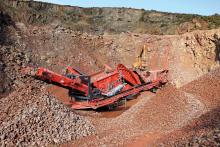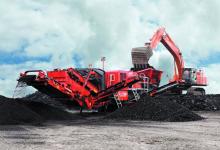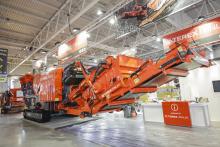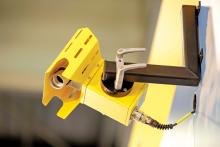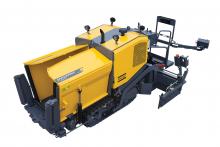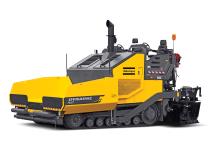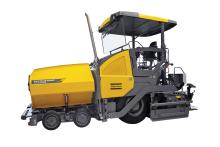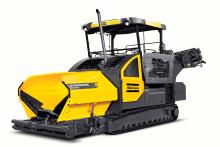New technology was one key focus area for the World of Asphalt/AGG1 event run recently in the US city of Baltimore - Mike Woof writes
Technology has been a major focus for the combined World of Asphalt and AGG1 2015 exhibition and conference held in Baltimore. The exhibition area attracted 450 exhibitors and covered a larger area than for previous events, while over 10,000 education season tickets were bought by those wanting to attend the presentation sessions. The event was held from March 17th- March
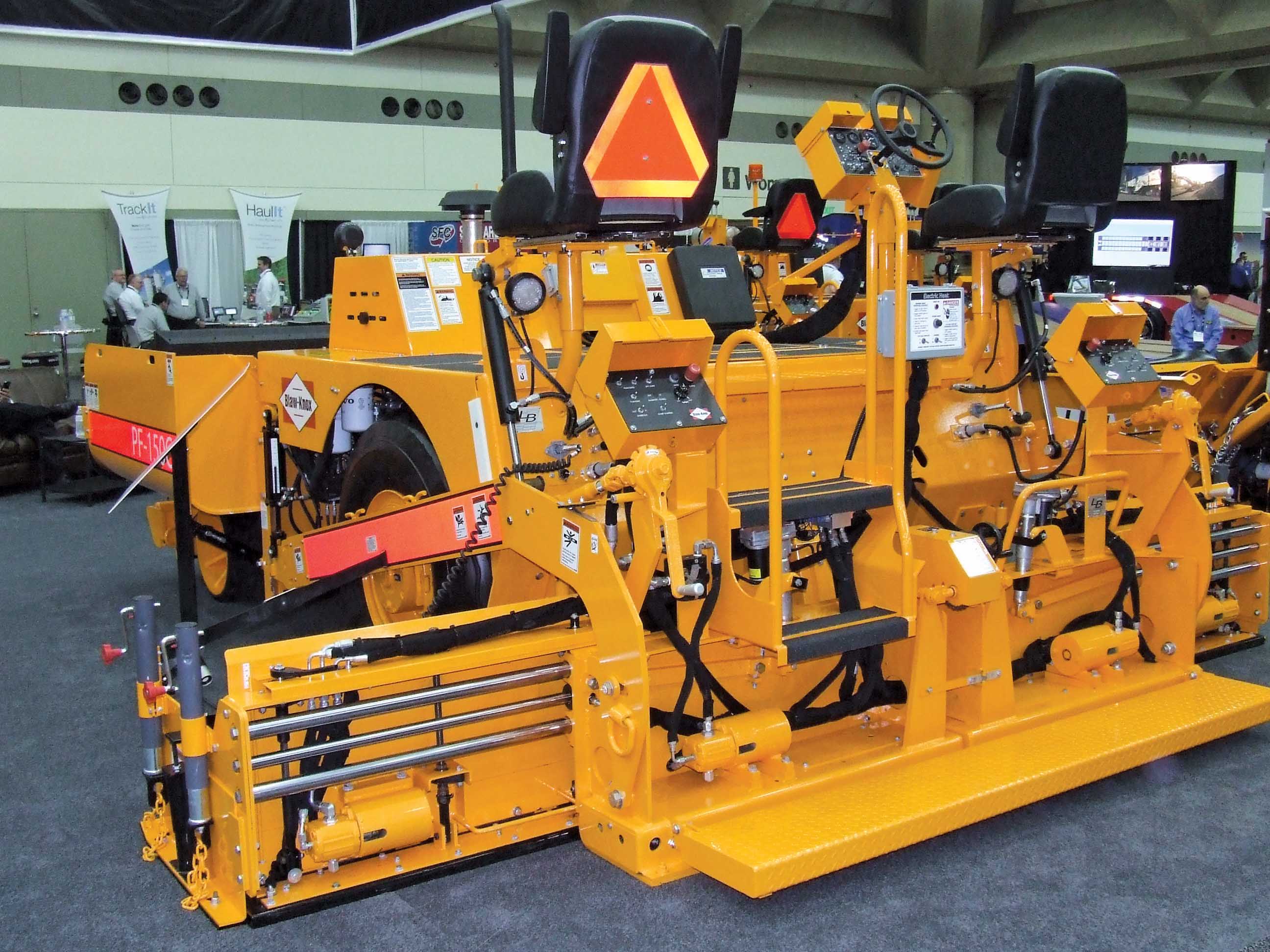
The PF-150C paver features increased power
New technology was one key focus area for the World of Asphalt/AGG1 event run recently in the US city of Baltimore - Mike Woof writes
Technology has been a major focus for the combined6069 World of Asphalt and AGG1 2015 exhibition and conference held in Baltimore. The exhibition area attracted 450 exhibitors and covered a larger area than for previous events, while over 10,000 education season tickets were bought by those wanting to attend the presentation sessions. The event was held from March 17th- March 19th at the Baltimore Convention Centre and was organised by the US-based 1100 Association of Equipment Manufacturers (AEM). The strong response for the event reflects encouraging signs of growth from the US road construction and quarrying segments during 2014 and which appears to be continuing into 2015.
161 Atlas Copco’s 206 Dynapac brand will offer increased performance for contractors. The new F1000T highway class paver is designed to handle mat widths from 3.05-7.92m. The machine benefits from a low deck height that helps with ease of transport, while offering good all-round visibility of key areas such as the screed, augers and hopper. Despite its productivity, the machine is said to have a compact design compared to other machines in its class, though its long tracks ensure good traction and stability.
The paver is prewired for use with machine control technology, although the342 Topcon system is the general option. Customers also have a choice of front or rear-mount screeds. Power comes from a 196 Cummins QSB6.7 diesel that is Tier 4 Final compliant and the machine has a powerful 34kW generator. This last unit is large enough to power all onboard machine functions as well as additional units such as extra lighting for night-time working.
Meanwhile Atlas Copco is also introducing a sophisticated new compaction control system that monitors the pass count and mat temperature. The system is said to eliminate the risks of over- or under-compaction and its results can be related to density estimation. The company does not claim it offers specific density calculation however. After carrying out a simple test trip, the machine can determine how many passes have to be carried out.
4018 Caterpillar Paving is on its new generation AP600 asphalt paver, which is available with new screeds, new controls and an integrated generator. Competing in the
2.55-5m paving class, the machine is equipped with a new generation diesel that meets the Tier 4 Final emissions requirements. A spokesperson for the firm said, “Our cooling and airflow hasn’t changed for Tier 4 Final and it helps for the visibility for the machine.”
A key feature is the new heating system for the screed, which is said to be highly efficient due to the direct drive, switched reluctance generator. Delivering 70kW, this generator helps heat the screed to a working temperature of 132°C in just 15 minutes. The spokesperson said, “It’s a really fast heat-up time. The generator is so efficient you save you fuel and switched reluctance allows us to keep a constant voltage whatever rpm the engine is turning at.”
The generator automatically adjusts the engine speed, while the operator can select a quiet warm-up setting when the machine is working in urban areas, which reduces engine speed and cuts noise, although the heat-up time is extended to 35 minutes as a result. The heating elements can also be removed quickly should they require maintenance.
The machine has new controls and panels and is equipped with the Cat Grade Control system, which is integrated into its electronics. The proven integrated fumes reduction system has been retained from the earlier generation machine. The spokesperson added, “We improved the visibility by moving the operator station forward and up and we also improved the visibility to the augers.”
3004 W.S. Tyler is now being rebranded as 8090 Haver & Tyler, so as to emphasise the broad range of solutions the company offers. Some of the sophisticated technology has been developed in Germany and offers additional capabilities. Marketing manager Kristen Randall said, “We just want to bring things altogether for our customers.”
One of the key technologies is the hydrocleaner for aggregates washing. This incorporates a drum lined with polythene and uses turbulence to clean aggregates effectively. Material then exits through the discharge belt and into a rinse screen, with the whole system fitting into a compact footprint compared with conventional technologies. Versions capable of 180tonnes/hour and 360tonnes/hour are available.
Also new from the firm is a sophisticated package that offers accurate vibration analysis of screening systems. Sensors can be put on key machine components. This data can then be downloaded onto a tablet device, allowing the customer to carry out detailed inspections without having to call out a service technician. Data can be downloaded to the firm and the system allows problems to be identified early and addressed quickly, without the risk of costly failures or extended downtime.
4982 McCloskey International shares many features of the firm’s J50 model, but is more compact and more mobile. The firm’s president and CEO Paschal McCloskey said, “It has the same power and capability as the first generation J50 but it has a smaller footprint.” The machine benefits from a longer jaw with a revised tip angle and McCloskey added, “It takes more material in and we get more tonnes/hour.”
Other crusher features include a reversible hydrostatic drive, reversible jaw plates and twin ram wedge closed side setting adjust. The feeder rate can be regulated either manually or automatically while the machine has a 12.8m long main conveyor as standard that is raised and lowered hydraulically and offers a large stockpiling capacity.
Weighing 50tonnes and featuring a compact design considering its throughput capacity, the J45 is said to be easy to transport. For transport, the machine is 3.4m high by 2.5m wide and 14.5m long. Power now comes from a783 Volvo Penta diesel that delivers 261kW and is Tier 4 Final compliant and McCloskey said, “Volvo did good work to fit the engine.”
The machine has been designed to make it easy to service, with direct access to hydraulics and McCloskey said, “It has a modern control system that will start and stop the feeder.”
He continued, “This new machine has been field-tested more than any machine we’ve done before.”
The machine features the firm’s high energy technology for its screenbox and the feeder is available with an independent pre-screen option. Another feature is the recirculation conveyor that can be specified by customers wanting to produce a crushed and screened product using a single machine.
1252 Roadtec continues to revise and upgrade its product range, with a major advance being the latest version of the firm’s Guardian telematics system, which is now being installed on the upgraded RX-600, RX-700 and RX-900 milling machines. A spokesperson for the company said, “It gives our customers better on-site support.”
In fact, the Guardian system offers considerably more benefits for users of Roadtec machines according to the firm. The spokesperson commented, “It’s above and beyond conventional telematics. We have a computer on board the machine that lets you see everything that’s happening with the machine. The new tool we’re offering on the milling machines is production reporting. You can tell exactly what’s coming off the conveyor belt.”
Other improvements for the mills include new grade and slope controls as well as new Tier 4 Final compliant diesels.
Meanwhile the firm’s RP195e asphalt paver is also benefiting from a Tier 4 Final compliant diesel, as is the latest version of the Shuttle Buggy material transfer vehicle. The latter also has a new Autotracking system as well as revised clean-out doors for easier cleaning at the end of a shift.
The new design also provides ease of maintenance. “You can change parts quickly,” said the spokesperson.
The 50mm thick wear liners are said to give extended working life while there are only a few profiles, so users can reduce the parts holding required and the spokesperson added, “Another option for ease of maintenance is the front opening machine.”
The crusher can reach reduction ratios of 30:1 in a single stage and can work with feed sizes of 200mm and reduce this to a 7 mesh size. The firm says that product sizes can be varied by changing the rotor speed as well as the spacing between the breaker bars and the apron breaker plates.
3501 Terex Finlay is particularly active with regard to new product development with the new J-1170AS model now ready for the market. Meanwhile the 1545 cone crusher and 873 screen are due shortly, with the latter following hard on the heels of the 673 model introduced late last year. And other models are also in development now, including a compact jaw crusher aimed at the recycling market.
The J-1170AS is a high performance primary mobile jaw crusher. Its central feature is the proven and productive Terex 1100mm x 700mm jaw crusher. A new feature of this model is the onboard detachable sizing screen. The machine’s jaw chamber is said to provide efficient material reduction and product sizing. The jaw chamber is available with an optional hydraulic release, an important feature when crushing construction and demolition debris. The hydraulic release option has an automatic overload protection system to prevent damage from uncrushable items in the feed material.
Power comes from either a Tier 3/Stage IIIA178 Caterpillar C9 delivering 261kW or a Tier 4 Interim/Stage IIIB 759 Scania DC9 rated at 257kW.
Hydrostatic transmission in the jaw chamber offers reversible operation in the event of a blockage. The hydrostatic system also provides variable chamber speed to suit given applications. The crusher features hydraulic assist Chamber CSS (Closed Side Setting) adjustment, and can be changed in a matter of minutes.
The machine has a heavy-duty variable speed vibrating grizzly feeder (VGF) with integrated pre-screen, to separate fines. The variable speed VGF ensures continuous choke feeding of the crushing chamber for optimal productivity. Material from the pre-screen can be diverted to a stockpile using the onboard by-pass conveyor, or join the crushed product on the main belt.
717 LeeBoy. The PF-150C paver is an improved version of the earlier B generation machine, with a new screed, more power, a higher power generator and a stronger structure with an increased weight of 181kg. The new screed is said to deliver better mat density and offers working widths of 2.44-4.3m. The 1265 Kubota diesel driving the machine is Tier 4 Interim compliant and delivers 75kW, a notable increase from the 63.4kW engine used previously. The generator output has been increased to 10kW compared with the previous 6.5kW, while 3157 Sauer Danfoss hydraulics are used throughout the machine.
New diagnostics are being fitted to the firm’s pavers, with this technology being installed on the PF-150C as well as the revised RW-35B road widener. The latter machine benefits also from a power increase to 28.3kW, compared with the 26.1kW engine used previously. The revised machine also has a new traction control system, redesigned front steering, new tyres and better braking, as well as improved engine access for maintenance.
359 Volvo CE is its new system that allows real-time density calculations for asphalt compaction. This technology has been developed as part of a PhD research project by Dr Fares Beainy of the University of Oklahoma. At the centre of the system is a sophisticated algorithm that makes the calculations based on data taken from sensors measuring the acceleration of the compactor’s drum as it moves up and down during vibration. Temperature sensors are also placed at the front and rear of the compactor.
Dr Beainy claims that the system is more accurate than competing technologies that determine mat stiffness or compaction values and said, “Density is what the operator needs to see on the screen.” He explained that the display is colour coded to show the operator the density achieved.
To use the system effectively, the operator has to use the machine on a short 10m test strip so that the package can calibrate itself according to the working conditions and the type of material being used. He said, “The algorithm is based on neural networking. The system learns what is soft and what is hard on a test strip.”
Dr Beainy added, “Basically it’s putting an experienced operator on each machine. It turns an inexperienced operator into an experienced operator.”
The ruggedised display is based on an Android tablet and shows the operator the number of passes carried out and the density achieved, as well as showing mat temperature.
7552 Zydex Industries is said to allow the construction of roads that will last longer and require fewer repairs. The key to this new system is a technology that helps boost waterproofing for the road substructure, as well as improving bonding between asphalt layers. As a result, roads are less vulnerable to damage from freeze thaw processes and will last longer.
According to Dr Ajay Ranka, CEO of Zydex, one of the problems with road construction is that inorganic materials are used that are water absorbent. These structural materials are then joined together to make asphalt by using bitumen, which is oil derived. However the water absorbent properties of the materials prevent efficient and comprehensive bonding processes to occur. But with the innovative new Zydex product, water can act as a catalyst for bonding to occur. As a result, the road materials bond more effectively, preventing early failure. The technology is particularly effective when used in combination with warm mix materials, which Ranka says are also more efficient. “What is important is warm compaction technology.”
The product also ensures improved bonding between each asphalt layer, as the emulsion layer is able to work more effectively according to Ranka. The same technology also extends to the use of tack coats, which can be made to be more durable and longer lasting. The Zydex product means also that contractors can utilise cold mix technology for applications where hot mix would usually be required. This is particularly important for rural road construction in developing nations, where materials may have to be transported long distance. Ranka said, “It will revolutionise rural road building around the world.”
Technology has been a major focus for the combined
Atlas Copco
Two new machine launches fromThe paver is prewired for use with machine control technology, although the
Meanwhile Atlas Copco is also introducing a sophisticated new compaction control system that monitors the pass count and mat temperature. The system is said to eliminate the risks of over- or under-compaction and its results can be related to density estimation. The company does not claim it offers specific density calculation however. After carrying out a simple test trip, the machine can determine how many passes have to be carried out.
Caterpillar
The key focus from2.55-5m paving class, the machine is equipped with a new generation diesel that meets the Tier 4 Final emissions requirements. A spokesperson for the firm said, “Our cooling and airflow hasn’t changed for Tier 4 Final and it helps for the visibility for the machine.”
A key feature is the new heating system for the screed, which is said to be highly efficient due to the direct drive, switched reluctance generator. Delivering 70kW, this generator helps heat the screed to a working temperature of 132°C in just 15 minutes. The spokesperson said, “It’s a really fast heat-up time. The generator is so efficient you save you fuel and switched reluctance allows us to keep a constant voltage whatever rpm the engine is turning at.”
The generator automatically adjusts the engine speed, while the operator can select a quiet warm-up setting when the machine is working in urban areas, which reduces engine speed and cuts noise, although the heat-up time is extended to 35 minutes as a result. The heating elements can also be removed quickly should they require maintenance.
The machine has new controls and panels and is equipped with the Cat Grade Control system, which is integrated into its electronics. The proven integrated fumes reduction system has been retained from the earlier generation machine. The spokesperson added, “We improved the visibility by moving the operator station forward and up and we also improved the visibility to the augers.”
Haver & Tyler
In the USOne of the key technologies is the hydrocleaner for aggregates washing. This incorporates a drum lined with polythene and uses turbulence to clean aggregates effectively. Material then exits through the discharge belt and into a rinse screen, with the whole system fitting into a compact footprint compared with conventional technologies. Versions capable of 180tonnes/hour and 360tonnes/hour are available.
Also new from the firm is a sophisticated package that offers accurate vibration analysis of screening systems. Sensors can be put on key machine components. This data can then be downloaded onto a tablet device, allowing the customer to carry out detailed inspections without having to call out a service technician. Data can be downloaded to the firm and the system allows problems to be identified early and addressed quickly, without the risk of costly failures or extended downtime.
McCloskey
The new J45 crusher fromOther crusher features include a reversible hydrostatic drive, reversible jaw plates and twin ram wedge closed side setting adjust. The feeder rate can be regulated either manually or automatically while the machine has a 12.8m long main conveyor as standard that is raised and lowered hydraulically and offers a large stockpiling capacity.
Weighing 50tonnes and featuring a compact design considering its throughput capacity, the J45 is said to be easy to transport. For transport, the machine is 3.4m high by 2.5m wide and 14.5m long. Power now comes from a
The machine has been designed to make it easy to service, with direct access to hydraulics and McCloskey said, “It has a modern control system that will start and stop the feeder.”
He continued, “This new machine has been field-tested more than any machine we’ve done before.”
The machine features the firm’s high energy technology for its screenbox and the feeder is available with an independent pre-screen option. Another feature is the recirculation conveyor that can be specified by customers wanting to produce a crushed and screened product using a single machine.
Roadtec
In fact, the Guardian system offers considerably more benefits for users of Roadtec machines according to the firm. The spokesperson commented, “It’s above and beyond conventional telematics. We have a computer on board the machine that lets you see everything that’s happening with the machine. The new tool we’re offering on the milling machines is production reporting. You can tell exactly what’s coming off the conveyor belt.”
Other improvements for the mills include new grade and slope controls as well as new Tier 4 Final compliant diesels.
Meanwhile the firm’s RP195e asphalt paver is also benefiting from a Tier 4 Final compliant diesel, as is the latest version of the Shuttle Buggy material transfer vehicle. The latter also has a new Autotracking system as well as revised clean-out doors for easier cleaning at the end of a shift.
Stedman
Stedman’s Grand Slam horizontal shaft impactor is said to be more efficient and offer higher productivity than earlier generation machines. The design has been revised to improve working efficiency and this also benefits throughput and wear life. A spokesperson for the firm said, “The majority of reduction comes with the first blow against the breaker bars. Our intake slope is 60°, combined with the shape of the mill to optimise product output.”The new design also provides ease of maintenance. “You can change parts quickly,” said the spokesperson.
The 50mm thick wear liners are said to give extended working life while there are only a few profiles, so users can reduce the parts holding required and the spokesperson added, “Another option for ease of maintenance is the front opening machine.”
The crusher can reach reduction ratios of 30:1 in a single stage and can work with feed sizes of 200mm and reduce this to a 7 mesh size. The firm says that product sizes can be varied by changing the rotor speed as well as the spacing between the breaker bars and the apron breaker plates.
Terex Finlay
The J-1170AS is a high performance primary mobile jaw crusher. Its central feature is the proven and productive Terex 1100mm x 700mm jaw crusher. A new feature of this model is the onboard detachable sizing screen. The machine’s jaw chamber is said to provide efficient material reduction and product sizing. The jaw chamber is available with an optional hydraulic release, an important feature when crushing construction and demolition debris. The hydraulic release option has an automatic overload protection system to prevent damage from uncrushable items in the feed material.
Power comes from either a Tier 3/Stage IIIA
Hydrostatic transmission in the jaw chamber offers reversible operation in the event of a blockage. The hydrostatic system also provides variable chamber speed to suit given applications. The crusher features hydraulic assist Chamber CSS (Closed Side Setting) adjustment, and can be changed in a matter of minutes.
The machine has a heavy-duty variable speed vibrating grizzly feeder (VGF) with integrated pre-screen, to separate fines. The variable speed VGF ensures continuous choke feeding of the crushing chamber for optimal productivity. Material from the pre-screen can be diverted to a stockpile using the onboard by-pass conveyor, or join the crushed product on the main belt.
VT LeeBoy
Updated machines are now being offered by VTNew diagnostics are being fitted to the firm’s pavers, with this technology being installed on the PF-150C as well as the revised RW-35B road widener. The latter machine benefits also from a power increase to 28.3kW, compared with the 26.1kW engine used previously. The revised machine also has a new traction control system, redesigned front steering, new tyres and better braking, as well as improved engine access for maintenance.
Volvo CE
A highly innovative development fromDr Beainy claims that the system is more accurate than competing technologies that determine mat stiffness or compaction values and said, “Density is what the operator needs to see on the screen.” He explained that the display is colour coded to show the operator the density achieved.
To use the system effectively, the operator has to use the machine on a short 10m test strip so that the package can calibrate itself according to the working conditions and the type of material being used. He said, “The algorithm is based on neural networking. The system learns what is soft and what is hard on a test strip.”
Dr Beainy added, “Basically it’s putting an experienced operator on each machine. It turns an inexperienced operator into an experienced operator.”
The ruggedised display is based on an Android tablet and shows the operator the number of passes carried out and the density achieved, as well as showing mat temperature.
Zydex Industries
A new technology fromAccording to Dr Ajay Ranka, CEO of Zydex, one of the problems with road construction is that inorganic materials are used that are water absorbent. These structural materials are then joined together to make asphalt by using bitumen, which is oil derived. However the water absorbent properties of the materials prevent efficient and comprehensive bonding processes to occur. But with the innovative new Zydex product, water can act as a catalyst for bonding to occur. As a result, the road materials bond more effectively, preventing early failure. The technology is particularly effective when used in combination with warm mix materials, which Ranka says are also more efficient. “What is important is warm compaction technology.”
The product also ensures improved bonding between each asphalt layer, as the emulsion layer is able to work more effectively according to Ranka. The same technology also extends to the use of tack coats, which can be made to be more durable and longer lasting. The Zydex product means also that contractors can utilise cold mix technology for applications where hot mix would usually be required. This is particularly important for rural road construction in developing nations, where materials may have to be transported long distance. Ranka said, “It will revolutionise rural road building around the world.”

